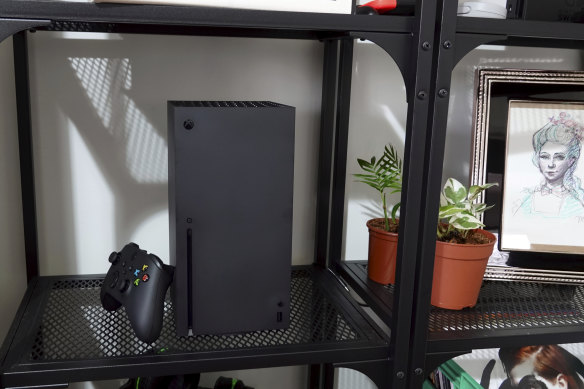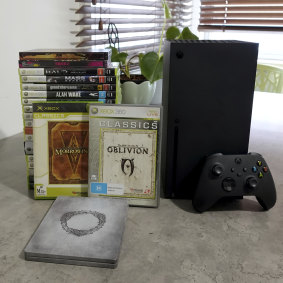This was published 4 years ago
Xbox Series X brings cutting edge tech to decades of games
By Tim Biggs
Next generation game consoles are less than a month away and, after seven long years with the current batch, there's plenty to get excited about. I spent the last couple of weeks testing a near-final preview unit of the Xbox Series X, and if it's emblematic of next-gen in general you can expect to see far fewer loading screens, effortless 60-frames-per-second gameplay at high resolutions, and support for all the brand new AV formats and functions that will doubtless make their way to your home theatre over the coming years.
The Series X is the brawnier of Xbox's pair of next-gen consoles, taking the form of a classy black obelisk that blended neatly into my loungeroom. Just imagine two 15cm cubes stacked on top of each other, or side-by-side if you want to lay it down, with a power button and a slot for a 4K Blu-ray drive. You need to give it plenty of room above or to the right for its massive (but very quiet) green-tinted exhaust fan, which could make it a tough fit inside some entertainment units.

The Series X demanded its own shelf in my lounge room, mostly because it wouldn't have fit where my current Xbox lives.Credit: Tim Biggs
New games that take full advantage of the system's specs (Microsoft says it has twice the graphics grunt of the Xbox One X and several times the processing power) will of course be the main selling point for the system, but my time with those was a bit limited. Luckily the Series X is designed to play and improve almost all Xbox One games, and many Xbox 360 and original Xbox games too, so I had plenty to test.
In fact using the Series X felt a lot more like upgrading all the parts in a PC than moving from one system to a totally new next-gen system. The console's interface — which may change pre-launch — was very similar to the existing Xbox One layout, albeit much faster, and all my games came with me automatically. Digital games appeared ready to download as soon as I signed in, while games I own physically needed to be copied over from the original disc. To save time I just copied all my games from Xbox One to a USB drive, and then from there to the Series X.
Native integration of old games might not be the sexiest next-gen feature, but I'm excited for how accessible decades of classics are on this machine. Even if you're new to gaming, the Microsoft Store (and the subscription Xbox Game Pass service) is stacked with goodness from Banjo Kazooie to Prince of Persia: Sands of Time to Mass Effect. And if you already have a big collection you can just keep playing here; save data for Xbox One games is synced in the cloud automatically. Pulling progress from the cloud for your Xbox 360 games is possible too, but you may need to upload those manually from your 360 if you still have it.
The most immediately noticeable next-gen advantage while playing games, and one that you can enjoy no matter what kind of TV you're using, comes from the cutting edge solid state storage drive. Compared to the mechanical HDDs in older systems, the SSD can access data and move it around incredibly fast, making for less time spent loading and more time spent playing.

I've been playing three generations of The Elder Scrolls on Xbox Series X, as well as heaps of other older games.Credit: Tim Biggs
On games designed specifically for Series X it's hard to quantify the SSD's performance since there's nothing to compare to, except to say it's quick. Loading up the Series X version of Gears Tactics was incredibly snappy compared to my experience of the PC version.
Legacy games allowed for a proper test as I could compare with Xbox One and its mechanical drive. In Halo 5, I found the time it took to load a save was halved from 24.4 seconds on Xbox One to 11.5 seconds on Series X. Playing Control, the load time was decreased by a full minute.
On even older games the improvement is remarkable. I dusted off my old Fallout 3 disc and found the Series X took just 2.9 seconds to load my save from 10 years ago, with loading screens between areas mostly reduced to a flicker. For anyone who played 360-era Bethesda games, you'll know this is quite a leap.
With load times significantly improved the biggest barrier to action was the long series of logos and splash screens that appear when you first boot a game, but Series X has a feature to more or less circumvent that too.
Quick Resume utilises the SSD to let you start a game exactly where you left off, even if you've been playing other games or completely unplugged the console, and it totally changed the way I jumped between games. I went from playing Doom Eternal to playing Final Fantasy XV — actually playing it, from the middle of the battle where I left off — in less than 12 seconds, with switching between games feeling just like flipping between smartphone apps. As long as you stick to the same handful of games you might not ever have to see a start screen again, though I'll need further testing to work out all the limits of this feature.
Beyond load times the performance of existing games was almost always boosted beyond what was previously possible. For example Final Fantasy XV and Rise of the Tomb Raider are both games which offered 60-frames-per-second modes on Xbox One but in practice couldn't hold that level. On Xbox Series X the framerate is flawless.
In fact every Xbox One game I tested, save for a few that the developers had locked to 30fps, ran at rock solid 60fps, which can be transformative. Older games were largely already improved on Xbox One X but are moreso here, with both GTA IV and Morrowind running in high resolution and at 60fps despite originally having extremely problematic frame rates.
It is possible for publishers to update their Xbox One games to remove frame and resolution caps for even better compatibility here — though who knows how likely that is to happen — and Xbox's Smart Delivery system means old games can even become fully-optimised Series X games for free if the publisher chooses.
So far the only game I've played that's done that is Gears 5 — and the campaign looks incredible in native 4K 60fps — but other planned upgrades include a 120fps version of Ori and the Will of the Wisps and a next-gen take on Assassin's Creed Valhalla, meaning you can buy the Xbox One version and have the Series X version waiting when you upgrade your machine.
Every next-gen optimised game confirmed for Xbox launch on November 10
- Assassins Creed Valhalla
- Borderlands 3
- Bright Memory 1.0
- Cuisine Royale
- Dead by Daylight
- Devil May Cry 5: Special Edition
- DIRT 5
- Enlisted
- Evergate
- The Falconeer
- Fortnite
- Forza Horizon 4
- Gears 5
- Gears Tactics
- Grounded
- King Oddball
- Maneater
- Manifold Garden
- NBA 2K21
- Observer: System Redux
- Ori and the Will of the Wisps
- Planet Coaster
- Sea of Thieves
- Tetris Effect: Connected
- The Touryst
- War Thunder
- Warhammer: Chaosbane Slayer Edition
- Watch Dogs: Legion
- WRC 9 FIA World Rally Championship
- Yakuza: Like a Dragon
- Yes, Your Grace
Those with brand new TVs featuring HDMI 2.1 ports will get the most out of next-gen games, with the Series X supporting 4K gameplay at up to 120 frames per second, as well as Dolby Vision HDR and Dolby Atmos sound.
Equipped with an LG CX OLED, I played Gears 5 multiplayer at 120fps and can see how it might become the standard for fast and twitchy experiences going forward. Upgrading from 60 to 120 is nowhere near as noticeable as going from 30 to 60, but it is a much smoother experience that makes your every action feel that much more immediate. At this early stage it's not worth dropping $6000 on a new TV solely to get 120fps gameplay, but it's great to have it supported for the future.
Perhaps more important is support for variable refresh rates via HDMI-VRR or FreeSync, which on new displays can dynamically match your screen's refresh rate to how many frames your game is pushing, eliminating tearing and artifacts that would previously occur if the game wasn't locked to a standard frame rate. With VRR, games can appear smooth even if the performance fluctuates, and it appears to work well on the Series X.
There's still a lot to dig into with this machine. I haven't yet seen any examples of games running ray-tracing for advanced real-time lighting, and the majority of my play has still been legacy games that as far as I can tell barely cause the system to break a sweat. But viewed as an upgrade from Xbox One X — or especially any of the older Xbox One systems — this is shaping up to be a very capable console that gives you access to cutting edge new experiences while also elevating the games you already love.